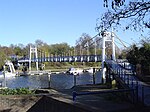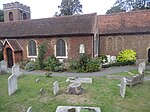Towpath murders

The towpath murders were a case in which two teenage girls were murdered on the towpath near Teddington Lock in Richmond upon Thames, London, England, on 31 May 1953. Alfred Charles Whiteway (1931 – 22 December 1953) was found guilty and hanged for the murders, which attracted much press attention, the case being described at the time as "one of Scotland Yard's most notable triumphs in a century". At the trial, defence counsel Peter Rawlinson had subjected lead detective Herbert Hannam to what was at the time considered a very sharp cross-examination on Whiteway's contention that the main evidence against him had been manufactured by police.
Excerpt from the Wikipedia article Towpath murders (License: CC BY-SA 3.0, Authors, Images).Towpath murders
Manor Road, London Ham (London Borough of Richmond upon Thames)
Geographical coordinates (GPS) Address Nearby Places Show on map
Geographical coordinates (GPS)
| Latitude | Longitude |
|---|---|
| N 51.431666666667 ° | E -0.32388888888889 ° |
Address
Manor Road
TW11 8BF London, Ham (London Borough of Richmond upon Thames)
England, United Kingdom
Open on Google Maps










